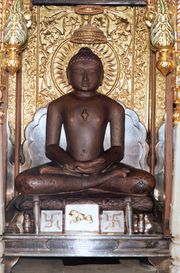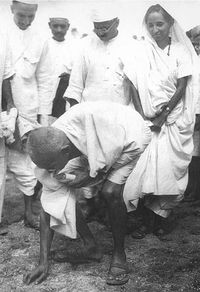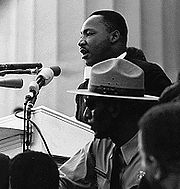Nonviolence
Nonviolence is a philosophy and strategy for social change that rejects the use of violence. Thus, nonviolence is an alternative to passive acceptance of oppression or of armed struggle against it. Nonviolence practitioners use diverse methods in their campaigns for social change, including critical forms of education and persuasion, civil disobedience and nonviolent direct action, and targeted communication via mass media.
In modern times, nonviolence is a powerful tool for social protest.[1][2][3] There are many examples of its use in nonviolent resistance and nonviolent revolution, including Mahatma Gandhi leading a decades-long nonviolent struggle against British rule in India, which eventually helped India win its independence in 1947, Martin Luther King's adoption of Gandhi's nonviolent methods in the struggle to win civil rights for African Americans, and César Chávez's campaigns of nonviolence in the 1960s to protest the treatment of farm workers in California.[4] The 1989 "Velvet Revolution" in Czechoslovakia that saw the overthrow of the Communist government[5] is considered one of the most important of the largely nonviolent Revolutions of 1989.[6] Most recently the nonviolent campaigns of Leymah Gbowee and the women of Liberia were able to achieve peace after a 14-year civil war.[7] This story is captured in a 2008 documentary film Pray the Devil Back to Hell.
The term "nonviolence" is often linked with or even used as a synonym for pacifism; however, the two concepts are fundamentally different. Pacifism denotes the rejection of the use of violence as a personal decision on moral or spiritual grounds, but does not inherently imply any inclination toward change on a sociopolitical level. Nonviolence on the other hand, presupposes the intent of (but does not limit it to) social or political change as a reason for the rejection of violence. Also, a person may advocate nonviolence in a specific context while advocating violence in other contexts.
Contents |
Forms
Advocates of nonviolence believe cooperation and consent are the roots of political power: all regimes, including bureaucratic institutions, financial institutions, and the armed segments of society (such as the military and police); depend on compliance from citizens.[8] On a national level, the strategy of nonviolence seeks to undermine the power of rulers by encouraging people to withdraw their consent and cooperation. The forms of nonviolence draw inspiration from both religious or ethical beliefs and political analysis. Religious or ethically based nonviolence is sometimes referred to as principled, philosophical, or ethical nonviolence, while nonviolence based on political analysis is often referred to as tactical, strategic, or pragmatic nonviolence. Commonly, both of these dimensions may be present within the thinking of particular movements or individuals.[9]
Philosophical

Love of the enemy, or the realization of the humanity of all people, is a fundamental concept of philosophical nonviolence. The goal of this type of nonviolence is not to defeat the enemy, but to win them over and create love and understanding between all.[10] According to Mark Kurlansky "All religions discuss the power of nonviolence and the evil of violence." Such principles or tenets can be found in each of the major Abrahamic religious traditions (Judaism, Christianity and Islam) as well as in the major Dharmic religious traditions (Hinduism, Buddhism, Jainism and Sikhism). Examples of nonviolence found in religion and spirituality include the Sermon on the Mount when Jesus urges his followers to "love thine enemy," in the Taoist concept of wu-wei, or effortless action, in the philosophy of the martial art Aikido, in the Buddhist principle of metta, or loving-kindness towards all beings; and in the principle of ahimsa, or nonviolence toward any being, shared by Buddhism, Jainism and some forms of Hinduism.[11] Additionally, focus on both nonviolence and forgiveness of sin can be found in the story of Abel in the Qur'an; Liberal movements within Islam have consequently used this story to promote Jewish ideals of nonviolence. Nonviolence is also part of modern pagan traditions.[12] An American author, Henry David Thoreau (1817–1862) had a major impact on the philosophy of nonviolence. Mohandas Gandhi and Martin Luther King Jr. were influenced by Thoreau.
Pragmatic
The fundamental concept of pragmatic (or tactical or strategic) nonviolence is to create a social dynamic or political movement that can effect social change without necessarily winning over those who wish to maintain the status quo.[10]
In modern industrial democracies, nonviolence has been used extensively by political sectors without mainstream political power such as labor, peace, environment and women's movements. Lesser known is the role that nonviolence has played and continues to play in undermining the power of repressive political regimes in the developing world and the former eastern bloc. Susan Ives emphasized this point with a quote from Walter Wink, "In 1989, thirteen nations comprising 1,695,000,000 people experienced nonviolent revolutions that succeeded beyond anyone's wildest expectations... If we add all the countries touched by major nonviolent actions in our century (Korea, the Philippines, South Africa... the independence movement in India...) the figure reaches 3,337,400,000, a staggering 65% of humanity! All this in the teeth of the assertion, endlessly repeated, that nonviolence doesn't work in the 'real' world."[6]
As a technique for social struggle, nonviolence has been described as "the politics of ordinary people", reflecting its historically mass-based use by populations throughout the world and history. Maybe the first of its kind which had huge political impact on history started from March 1 movement in Korea and later it influenced Gandhi's campaign as well. The March 1 Movement was a catalyst for the establishment of the Provisional Government of the Republic of Korea in Shanghai in April 1919 and also gave influence on nonviolent resistance in India and many other countries[13] . Struggles most often associated with nonviolence are the non co-operation campaign for Indian independence led by Mohandas Karamchand Gandhi, the movement to attain civil rights for African Americans, led by Martin Luther King and James Bevel, and People Power in the Philippines.
Also of primary significance is the notion that just means are the most likely to lead to just ends. When Gandhi said that "the means may be likened to the seed, the end to a tree," he expressed the philosophical kernel of what some refer to as prefigurative politics. Martin Luther King, a student of Gandhian nonviolent resistance, concurred with this tenet of the method, concluding that "...nonviolence demands that the means we use must be as pure as the ends we seek." Proponents of nonviolence reason that the actions taken in the present inevitably re-shape the social order in like form. They would argue, for instance, that it is fundamentally irrational to use violence to achieve a peaceful society. People have come to use nonviolent methods of struggle from a wide range of perspectives and traditions. A landless peasant in Brazil may nonviolently occupy a parcel of land for purely practical motivations. If they do not, the family will starve. A Buddhist monk in Thailand may "ordain" trees in a threatened forest, drawing on the teachings of Buddha to resist its destruction. A waterside worker in England may go on strike in socialist and union political traditions. All the above are using nonviolent methods but from different standpoints. Likewise, secular political movements have utilized nonviolence, either as a tactical tool or as a strategic program on purely pragmatic and strategic levels, relying on its political effectiveness rather than a claim to any religious, moral, or ethical worthiness.

Respect or love for opponents also has a pragmatic justification, in that the technique of separating the deeds from the doers allows for the possibility of the doers changing their behavior, and perhaps their beliefs. Martin Luther King said, "Nonviolence means avoiding not only external physical violence but also internal violence of spirit. You not only refuse to shoot a man, but you refuse to hate him."
Finally, the notion of Satya, or truth, is central to the Gandhian conception of nonviolence. Gandhi saw truth as something that is multifaceted and unable to be grasped in its entirety by any one individual. All carry pieces of the truth, he believed, but all need the pieces of others’ truths in order to pursue the greater truth. This led him to believe in the inherent worth of dialogue with opponents, in order to understand motivations. On a practical level, the willingness to listen to another's point of view is largely dependent on reciprocity. In order to be heard by one's opponents, one must also be prepared to listen.
Nonviolence has even obtained a level of institutional recognition and endorsement at the global level. On November 10, 1998, the United Nations General Assembly proclaimed the first decade of the 21st century and the third millennium, the years 2001 to 2010, as the International Decade for the Promotion of a Culture of Peace and Non-Violence for the Children of the World.
Living
For many, practicing nonviolence goes deeper than withholding from violent behavior or words. It means caring in one's heart for everyone, even those one strongly disagrees with, that is who are antithetical or opposed. For some, this principle entails a commitment to restorative or transformative justice and prison abolition. By extrapolation comes the necessity of caring for those who are not practicing nonviolence, who are violent. Of course no one can simply will themselves to have such care, and this is one of the great personal challenges posed by nonviolence - once one believes in nonviolence in theory, how can the person live it? It requires an opening of the heart and mind to all of existence, and a deep love for all that is. Because we are all interconnected, to love oneself is to love everyone; to hate another is to hate oneself. Because we learn violence, it is necessary to unlearn that violence through practicing love and compassion at every possible opportunity.
Respect
Nonviolence, for many, involves a respect and reverence for all sentient and non-sentient beings. This might include the practice of not eating animal flesh (vegetarianism or veganism), religious practices of non-harm to all beings (Jainism, for example), and caring for the welfare of all beings. Mohandas Gandhi, James Bevel, and other nonviolent proponents advocated vegetarianism as part of their nonviolent philosophy. Buddhists extend this respect for life to animals, plants, and even minerals.
Methods

Nonviolent action generally comprises three categories: Acts of Protest and Persuasion, Noncooperation, and Nonviolent Intervention.[14]
Acts of protest
Nonviolent acts of protest and persuasion are symbolic actions performed by a group of people to show their support or disapproval of something. The goal of this kind of action is to bring public awareness to an issue, persuade or influence a particular group of people, or to facilitate future nonviolent action. The message can be directed toward the public, opponents, or people affected by the issue. Methods of protest and persuasion include speeches, public communications, petitions, symbolic acts, art, processions (marches), and other public assemblies.[15]
Noncooperation
Noncooperation involves the purposeful withholding of cooperation or the unwillingness to initiate in cooperation with an opponent. The goal of noncooperation is to halt or hinder an industry, political system, or economic process. Methods of noncooperation include labor strikes, economic boycotts, civil disobedience, tax refusal, and general disobedience.[15]
Nonviolent intervention
Nonviolent intervention, compared to protest and noncooperation, is a more direct method of nonviolent action. Nonviolent intervention can be used defensively—for example to maintain an institution or independent initiative—or offensively- for example to drastically forward a nonviolent struggle into the opponent's territory. Intervention is often more immediate and effective than the other two methods, but is also harder to maintain and more taxing to the participants involved. Methods of intervention includes occupations (sit-ins), blockades, fasting (hunger strikes), truck cavalcades, and dual sovereignty/parallel government.[15]
Tactics must be carefully chosen, taking into account political and cultural circumstances, and form part of a larger plan or strategy. Gene Sharp, a political scientist and nonviolence activist, has written extensively about methods of nonviolence. In his book "Waging Nonviolent Struggle" he describes 198 methods of nonviolent action.[16] In early Greece, Aristophanes' Lysistrata gives the fictional example of women withholding sexual favors from their husbands until war was abandoned. The deterrence of violent attack and promotion peaceful resolution of conflicts, as a method of intervention across borders, has occurred throughout history with some failures (at least on the level of deterring attack) such as the Human Shields in Iraq because it failed to ascertain the value of the goal compared with the value of human life in its context of war; but also many successes, such as the work of the Guatemala Accompaniment Project.[17] Several non-governmental organizations, including Peace Brigades International and Christian Peacemaker Teams, are working in this area. Their primary tactics are unarmed accompaniment, human rights observation, and reporting.[18][19]
Another powerful tactic of nonviolent intervention invokes public scrutiny of the oppressors as a result of the resisters remaining nonviolent in the face of violent repression. If the military or police attempt to violently repress nonviolent resisters, the power to act shifts from the hands of the oppressors to those of the resisters. If the resisters are persistent, the military or police will be forced to accept the fact that they no longer have any power over the resisters. Often, the willingness of the resisters to suffer has a profound effect on the mind and emotions of the oppressor, leaving them unable to commit such a violent act again.[20][21]
Green politics
| Part of the Politics series on |
| Green politics |
|---|
 |
|
Core topics
|
|
Four Pillars
|
|
Schools
Bright green environmentalism
Deep ecology Eco-feminism · Eco-socialism Green anarchism Green conservatism Green left · Green liberalism Green libertarianism Green municipalism Green Zionism Green syndicalism Social ecology |
|
Organizations
in Africa
in the Americas Asia-Pacific Green Network European Green Party Young European Greens Global Greens Global Young Greens Green Zionist Alliance Green parties |
|
Related topics
Conservation movement
Eco-capitalism Ecology movement Ecocentrism Environmentalism Free-market environmentalism Green libertarianism Green Zionism Environmental issues |
Politics portal |
Nonviolence has been a central concept in green political philosophy. It is included in the Global Greens Charter. Greens believe that society should reject the current patterns of violence and embrace nonviolence. Green Philosophy draws heavily on both Gandhi and the Quaker traditions, which advocate measures by which the escalation of violence can be avoided, while not cooperating with those who commit violence. These greens believe that the current patterns of violence are incompatible with a sustainable society because it uses up limited resources and many forms of violence, especially nuclear weapons, are damaging for the environment. Violence also diminishes one and the group.
Some green political parties, like the Dutch GroenLinks, evolved out of the cooperation of the peace movement with the environmental movement in their resistance to nuclear weapons and nuclear energy.
As Green Parties have moved from the fringes of society towards becoming more and more influential in government circles, this commitment to nonviolence has had to be more clearly defined. In many cases, this has meant that the party has had to articulate a position on nonviolence that differentiates itself from classic pacifism. The leader of the German Greens, for example, was instrumental in the NATO intervention in Serbia, arguing that being in favor of nonviolence should never lead to passive acceptance of genocide. Similarly, Elizabeth May of the Green Party of Canada has stated that the Canadian intervention in Afghanistan is justified as a means of supporting women's rights.
This support for military action by Green Party leaders has led to criticism from within its membership in Canada and Germany, because the bombing of Serbia and military movements against the Afghan Taliban are viewed as clear violations of nonviolent principles.
Revolution
Certain individuals (Barbara Deming, Danilo Dolci, Devere Allen etc.) and party groups (e.g. Committees of Correspondence for Democracy and Socialism, Democratic Socialists of America, Socialist Party USA, Socialist Resistance, Pacifist Socialist Party or War Resisters League) have advocated nonviolent revolution as an alternative to violence as well as elitist reformism. This perspective is usually connected to militant anti-capitalism.
Many leftist and socialist movements have hoped to mount a "peaceful revolution" by organizing enough strikers to completely paralyze it. With the state and corporate apparatus thus crippled, the workers would be able to re-organize society along radically different lines. Some have argued that a relatively nonviolent revolution would require fraternisation with military forces.[22]
Criticism
Leon Trotsky, Frantz Fanon, Reinhold Niebuhr, Subhash Chandra Bose, George Orwell, Ward Churchill[23] and Malcolm X were fervent critics of nonviolence, arguing variously that nonviolence and pacifism are an attempt to impose the morals of the bourgeoisie upon the proletariat, that violence is a necessary accompaniment to revolutionary change, or that the right to self-defense is fundamental.
In the midst of violent repression of radical African Americans in the United States during the 1960s, Black Panther member George Jackson said of the nonviolent tactics of Martin Luther King, Jr.:
"The concept of nonviolence is a false ideal. It presupposes the existence of compassion and a sense of justice on the part of one's adversary. When this adversary has everything to lose and nothing to gain by exercising justice and compassion, his reaction can only be negative."[24][25]
Malcolm X also clashed with civil rights leaders over the issue of nonviolence, arguing that violence should not be ruled out where no option remained:
- "I believe it's a crime for anyone being brutalized to continue to accept that brutality without doing something to defend himself."[26]
Lance Hill criticizes nonviolence as a failed strategy and argues that black armed self-defense and civil violence motivated civil rights reforms more than peaceful appeals to morality and reason (see Lance Hill's "Deacons for Defense").[27]
In his book How Nonviolence Protects the State, anarchist Peter Gelderloos criticizes nonviolence as being ineffective, racist, statist, patriarchal, tactically and strategical inferior to militant activism, and deluded.[28] Gelderloos claims that traditional histories whitewash the impact of nonviolence, ignoring the involvement of militants in such movements as the Indian independence movement and the Civil Rights movement and falsely showing Gandhi and King as being their respective movements' most successful activists.[29] He further argues that nonviolence is generally advocated by privileged white people who expect "oppressed people, many of whom are people of color, to suffer patiently under an inconceivably greater violence, until such time as the Great White Father is swayed by the movement's demands or the pacifists achieve that legendary 'critical mass.'"[30]
The efficacy of nonviolence was also challenged by some anti-capitalist protesters advocating a "diversity of tactics" during street demonstrations across Europe and the US following the anti-World Trade Organization protests in Seattle, Washington in 1999. American feminist writer D. A. Clarke, in her essay "A Woman With A Sword," suggests that for nonviolence to be effective, it must be "practiced by those who could easily resort to force if they chose." This argument reasons that nonviolent tactics will be of little or no use to groups that are traditionally considered incapable of violence, since nonviolence will be in keeping with people's expectations for them and thus go unnoticed. Such is the principle of dunamis (from the Greek: δύνάμις or, restrained power).
See also
- Category:Nonviolence organizations
- Category:Scholars and leaders of nonviolence, or nonviolent resistance
- Ahimsa
- Anti-war
- Anarcho-pacifism
- Christian anarchism
- Christian pacifism
- Civil disobedience
- Conflict Resolution
- Consistent life ethic
- Department of Peace
- Direct action
- Nonkilling
- Nonresistance
- Nonviolent Communication
- Nonviolent resistance
- Nonviolent revolution
- Pacifism
- Satyagraha
- Transformative justice
- Turning the other cheek
- War resister
References
- ↑ Ronald Brian Adler, Neil Towne, Looking Out/Looking In: Interpersonal Communication, 9th ed. Harcourt Brace College Publishers, p. 416, 1999. "In the twentieth century, nonviolence proved to be a powerful tool for political change."
- ↑ Lester R. Kurtz, Jennifer E. Turpin, Encyclopedia of Violence, Peace, and Conflict, p.557, 1999. "In the West, nonviolence is well recognized for its tactical, strategic, or political aspects. It is seen as a powerful tool for redressing social inequality."
- ↑ Mark Kurlansky, Nonviolence: The History of a Dangerous Idea, Foreward by Dalai Lama, p. 5-6, Modern Library (April 8, 2008), ISBN 0812974476 "Advocates of nonviolence — dangerous people — have been there throughout history, questioning the greatness of Caesar and Napoleon and the Founding Fathers and Roosevelt and Churchill."
- ↑ Stanley M. Burstein and Richard Shek: "World History Ancient Civilizations ", page 154. Holt, Rinhart and Winston, 2005. As Chavez once explained, "Nonviolence is not inaction. It is not for the timid or the weak. It is hard work, it is the patience to win."
- ↑ RP's History Online - Velvet Revolution
- ↑ 6.0 6.1 Ives, Susan (19 October 2001). "No Fear". Palo Alto College. http://salsa.net/peace/article38.html. Retrieved 2009-05-17
- ↑ Chris Graham, Peacebuilding alum talks practical app of nonviolence, Augusta Free Press, October 26, 2009.
- ↑ Sharp, Gene (1973). The Politics of Nonviolent Action. Porter Sargen. p. 12. ISBN 9780875580685.
- ↑ Two Kinds of Nonviolent Resistance ~ Civil Rights Movement Veterans
- ↑ 10.0 10.1 Nonviolent Resistance & Political Power ~ Civil Rights Movement Veterans (U.S.)
- ↑ Mark Kurlansky, Nonviolence: The History of a Dangerous Idea, p. 7-13, p. 33.
- ↑ Kristen Madden, Raven Grimassi, Starhawk, Exploring the Pagan Path: Wisdom from the Elders, p. 259, Career Press, 2005 ISBN 1-56414-788-6
- ↑ http://www.koreafocus.or.kr/design2/layout/content_print.asp?group_id=102423
- ↑ United Nations International Day of Non-Violence, United Nations, 2008. see International Day of Non-Violence.
- ↑ 15.0 15.1 15.2 Sharp, Gene (2005). Waging Nonviolent Struggle. Extending Horizon Books. pp. 50–65. ISBN 0875581625.
- ↑ Sharp, Gene (1973). The Methods of Nonviolent Action. Peace magazine. http://peacemagazine.org/198.htm. Retrieved 2008-11-07
- ↑ Network in Solidarity with the People of Guatemala
- ↑ "PBI's principles". Peace Brigades International. PBI General Assembly. 1992, 2001. http://www.peacebrigades.org/about-pbi/how-we-work/. Retrieved 2009-05-17.
- ↑ "Christian Peace Maker Teams Mission Statement". Christian Peacemaker Team. CPT founding conference. 1986. http://www.cpt.org/about/mission. Retrieved 2009-05-17.
- ↑ Sharp, Gene (1973). The Politics of Nonviolent Action. P. Sargent Publisher. p. 657. ISBN 9780875580685.
- ↑ Sharp, Gene (2005). Waging Nonviolent Struggle. Extending Horizon Books. p. 381. ISBN 0875581625.
- ↑ Dan Jakopovich: Revolution and the Party in Gramsci's Thought: A Modern Application.
- ↑ Churchill, Ward et al. Pacifism as Pathology. Arbeiter Ring, 1998.
- ↑ Jackson, George. Soledad Brother: The Prison Letters of George Jackson. Lawrence Hill Books, 1994. ISBN 1-55652-230-4
- ↑ Walters, Wendy W. At Home in Diaspora. U of Minnesota Press, 2005. ISBN 0-8166-4491-8
- ↑ X, Malcolm and Alex Haley:"The Autobiography of Malcolm X", page 366. Grove Press, 1964
- ↑ The Deacons for Defense:Armed Resistance and the Civil Rights Movement By Lance Hill, The University of North Carolina Press
- ↑ Gelderloos, Peter. How Nonviolence Protects the State. Boston: South End Press, 2007.
- ↑ Ibid., p.7-12.
- ↑ Ibid., p.23.
Further reading
- ISBN 9780850663365 Making Europe Unconquerable: the Potential of Civilian-Based Deterrence and Defence (see article), by Gene Sharp
- ISBN 0-87558-162-5 Waging Nonviolent Struggle: 20th Century Practice And 21st Century Potential by Gene Sharp with collaboration of Joshua Paulson and the assistance of Christopher A. Miller and Hardy Merriman
- ISBN 0-8166-4193-5 Unarmed Insurrections: People Power Movements in Non-Democracies by Kurt Schock
- OCLC 03859761 The The Kingdom of God Is Within You by Leo Tolstoy
- ISBN 1-930722-35-4 Is There No Other Way? The Search for a Nonviolent Future by Michael Nagler
- ISBN 1-57766-349-7 Nonviolence in Theory and Practice, 2nd edition, edited by Robert L. Holmes and Barry L. Gan
- ISBN 0-85283-262-1 People Power and Protest since 1945: A Bibliography of Nonviolent Action, compiled by [April Carter], Howard Clark, and [Michael Randle], online at [1] with updates.
- ISBN 978-0-903517-21-8 Handbook for Nonviolent Campaigns, War Resisters' International
External links
- Nonviolent activism at the Open Directory Project
- Nonviolence in philosophy at the Open Directory Project
|
||||||||||||||||
